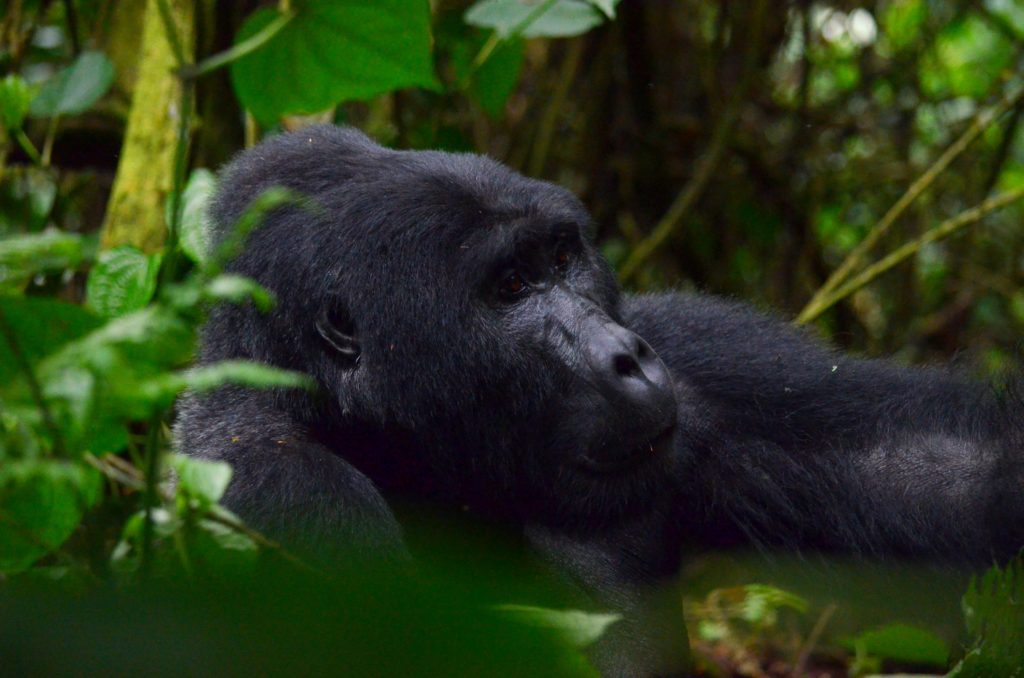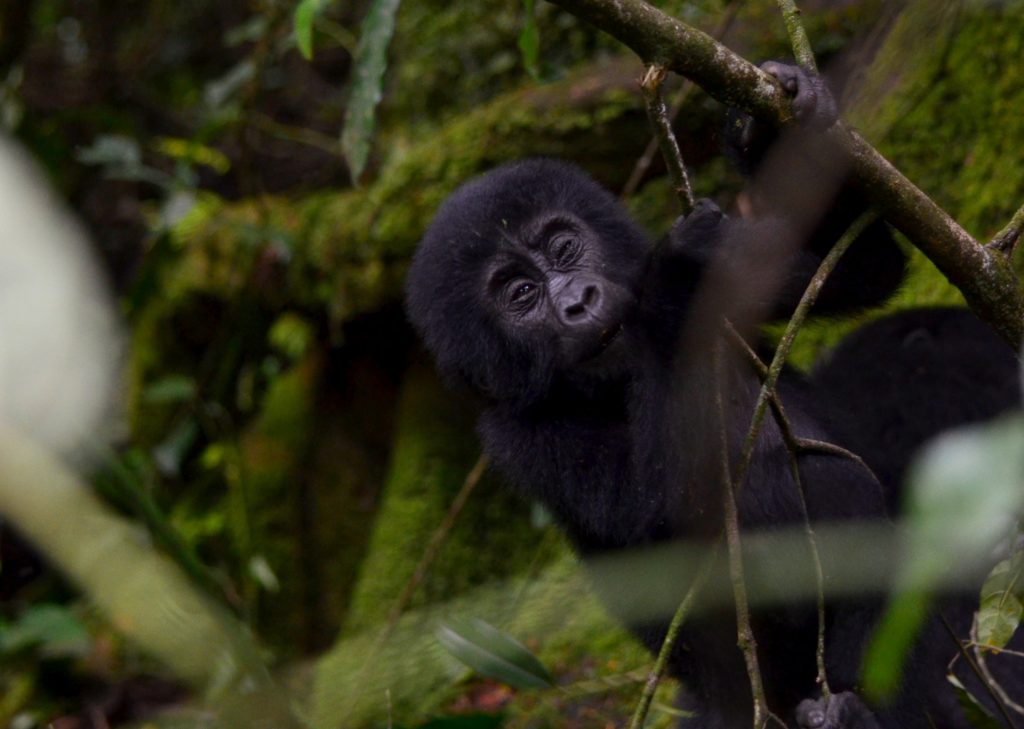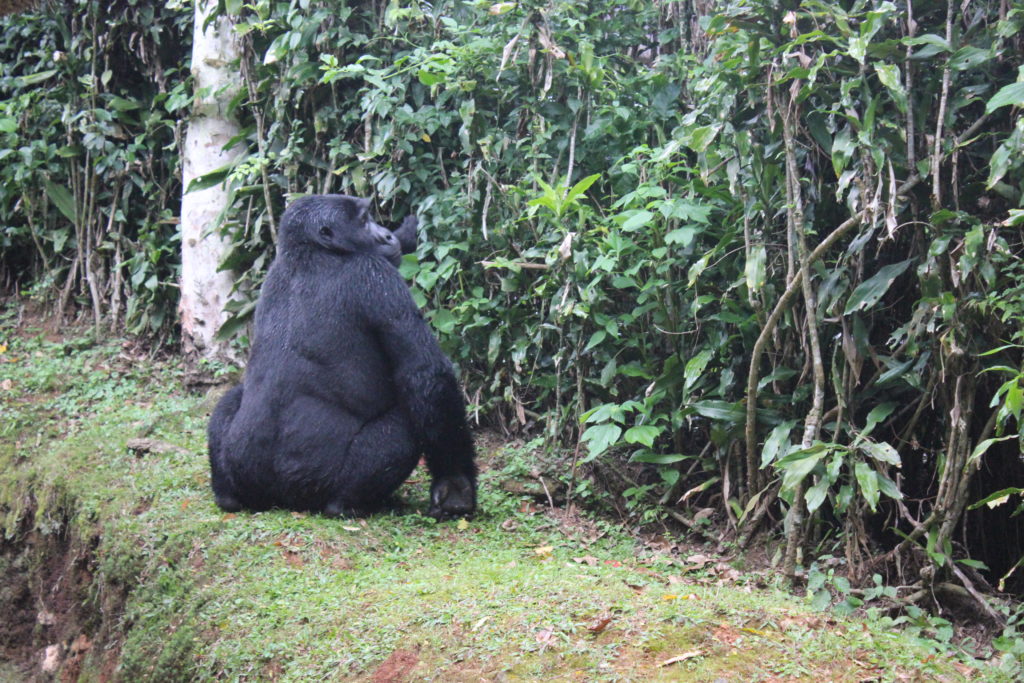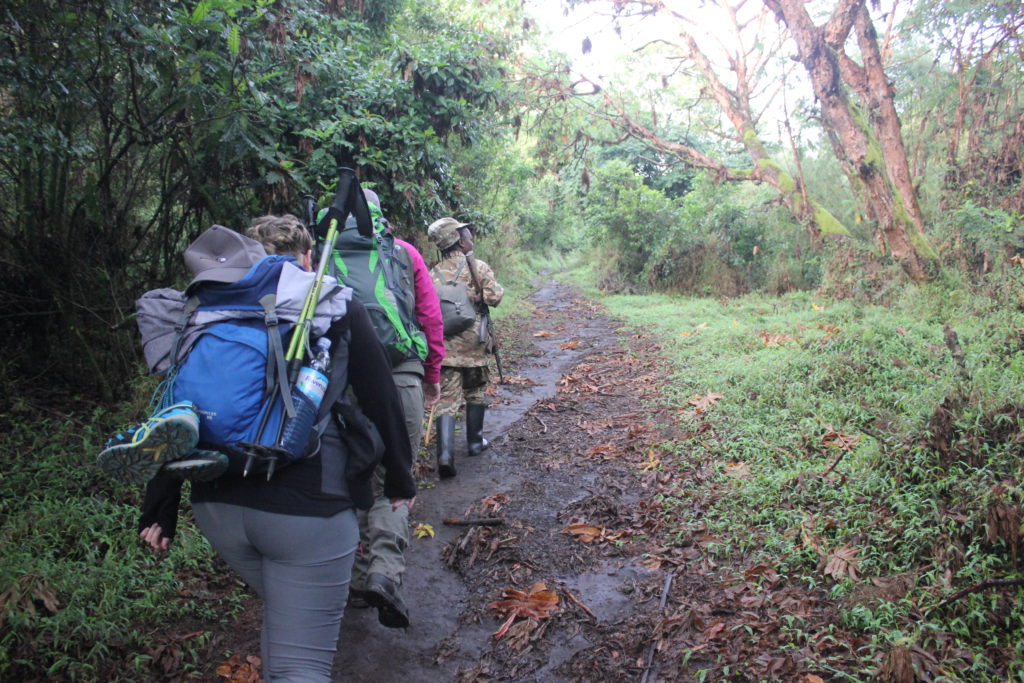Mountain Gorilla Trekking is a phenomenal primate experience carried out within the misty blanketed forests of the Virunga landscape that are shared between Uganda, Rwanda and the Democratic Republic of Congo. It is arguably the most defined adrenaline activity of any Ugandan and Rwandan safari. The trekking is a true interesting phenomenon that combines the beauty of nature together with the thrill for pleasure, in effect offering one the best so deserved. The trekking experience also has to it attached the sense of feeling that one is in a completely different world, where much pragmatism as concerned with learning about nature simultaneously occurs as the whole movie scenes of King kong get clearer in essence and established in realty.
Gorilla trekking ushers one into the mystical concealments of the Virunga forests that have seen both hot and cold over the years. It is these intact forested perfections that charmingly and amazingly gaze and sway to any adventurer who signs up for the task of trekking the forest with a compelling force to respond by either swaying back or relaxing the mind.
What is a gorilla trekking tour all about?
Gorilla trekking involves hiking the forested mountains in search for the hidden gems (mountain gorillas) that punctuate the diverse landscapes of the area. These spectacular creatures with their human-like poses and behaviour cultivate an intrinsic joy and happiness in every adventurer and traveler. It is this captivating sight of a paradisiacal place with stunning creatures that inspires many to keep moving until they reach a relaxing troupe or group of gorillas. Normally, the trek is truthfully of a long and agonizing type (2 to 6 hours trek), thereby shortly pronouncing “tiredom” to many of those who choose to embark on it.
During the trek, the guide keeps dissipating relevant information which enhances numerous interesting interactions and discussions amongst the team members. All this in turn creates social cohesion and works magic for those whose hobby-list includes making friends. The trek usually starts in a strategic vein with a briefing from the information centre. There after, the team of trekkers is then ushered into the forest with guides and rangers that enhance safety and security. The forest is divided in different trailheads for those who want to track gorillas.
What exactly are the mountain gorillas?
Generally, gorillas are ground-dwelling and herbivorous apes that inhabit the forests of central and Sub-saharan Africa. Gorilla is a genus and is divided into two species that include the eastern and western gorillas, although it is estimated that there are either four or five subspecies. Gorillas are the largest primates and their DNA is similar to that of humans, with a range of between 95 to 99% basing on what is considered. They are the next closest relatives to human beings after the chimps and bonobos. Gorillas’ natural habitats cover forest and have a wide range of elevations.
Mountain gorillas are one of the most endangered animals on the planet. Decimated by diseases, wars and hunters that used to inhabit the forest, they now remain to a tune of an estimated 1063 in the wild, marooned in a handful of a series of pockets in the forested mountains of the Virunga landscape. The gorillas live in a wind-pitted place, with mist that blankets the intact forested perfections. They occur in a wild part of the world, ethereal landscape that has to be seen to be believed!! The mountain gorilla can only be found within the Albertine rift, living in altitudes that range from 2,200 to 4,300 metres.
However, lowland gorillas live in dense forests and lowland swamps and are phenotypically (physically) different from the mountain gorillas. You could be probably wondering why the Gorilla is so popular; the mountain gorilla is an ape of unmatchable magnificence, and soon enough, just like it is with the less popular attractions in Bwindi, the rest of Uganda’s wildlife attractions will be merely basking in the gorilla’s reflected glory. Scientists observe that the Gorilla is the closest relative of the human race, possessing 99% human DNA. But this alone could not be sufficient to win the Gorilla the fame it presently enjoys.
The actual source of the Gorilla’s popularity is a combination of its closeness with human kind, its endemicity and endangered status as explained above. In the 1980s, the known population of mountain gorillas (Gorilla beringei beringei) in the Virunga Mountains had dwindled to just 240 individuals, as lost habitat, hunting, disease and other threats had exacted a costly toll. By the late 2018, though, more than three decades of “extreme conservation” involving the day-to-day protection of gorilla families appeared to be having an impact: A 2016 survey of the gorillas living in the Virungas revealed an increase to 604 animals.
As of 2017, the total population of mountain gorillas had been estimated at 700 individuals, which made their status citically endangered according to IUCN. (International Union for Conservation of Nature) Currently, according to the 2018 census of the Bwindi-Sarambwe population, which straddles the border between Uganda and the Democratic Republic of Congo, the mountain gorillas are now standing at an estimated 1063 individuals, which has elevated their status to endangered.
Particularly in Uganda, the mountain gorillas currently occur at an estimated 459 count, and existing in 50 groups or families. Of these 50 groups, 21 have been habituated for tourism and are available for gorilla trekking. These 21 groups are found within various gorilla trekking sectors. Buhoma has 5 gorilla habituated groups; Rushegura, Mubaare, Muyambi, Katwe and Habiyanja. Ruhija is considered the most remote sector of all the four and has 4 groups; Bitukura, Mukiza, Oruzogo and Kyaguliro. In Ruhija, there’s also a three hour hike to visit the Mubwindi swamp. Rushaga has 10 groups namely; Kahungye, Mishaya, Bweeza, Nshongi (has 36 members including 5 silverbacks), Busingye, Kutu, Mucunguzi, Rwigi and Bikingyi.
Nkulingo which is about 10km from Buhoma has 2 groups; Nkuringo and Christmas. Last year, Hirwa group, which means lucky one in native Kinyarwanda crossed from Volcanoes National Park to Mgahinga National Park in Uganda. Contrary to its name, the group suffered a great loss when it was struck by a lightning in Frebruary 2020 which led to the death of four of its 20 members. Following this disaster, the group moved back to Rwanda in may.
Visiting the virungas for gorilla trekking can be as humbling as it is exciting. Visitors often narrate how unforgettable the experience of close eye contact with a gorilla is, how they were spellbound by the gentility of the adult Gorilla and the cheekiness of the showy young ones, how they were ‘humbled’ by the manner in which Gorillas create order in their families and take care of their offspring and how in just a few hours they got so attached to the forest to a point of not wanting to leave. Gorilla tracking can be done throughout the year, though we have observed that the peak seasons are June-September, and December-February when there is relatively less rainfall in the forest.
However, even if you feel excited now, please keep in mind that the mountain gorillas cannot be visited without a permit for each tourist, because there are only a few of them left and are thus highly protected and cared for, lest any act of negligence should wipe out even the few remaining ones. The Tracking process thus begins with obtaining a gorilla tracking permit at either the Uganda Wildlife Authority offices in Kampala or the Rwanda Development Board offices in Kigali or Ruhengeri which is near the park. So make sure to book the permits in advance due to the high demand.
Permits are issued out basing on the available slots in the Park’s gazetted gorilla groups. The cost of permits varies a lot and increases nearly every year. These permits should be secured several months before if possible, so as to avoid missing out getting one for a desired date. Permits can be paid for up to two years in advance, although its highly recommended to book at least 2 to 5 months before your gorilla trekking safari. Gorilla Trekking permits should be under your own names and never allow to use permits that are not under your names.
A gorilla permit in Uganda currently costs US $700 from July 2020. The price has been increased from US$ 600 to 700 per permit for Foreign non residents, and US$500 to US$600 for Foreign residents. However, it is still at US$ 600 till July. In Rwanda, the gorilla trekking permit is at US$1500. Because the gorilla is closely related to human beings and can easily contract human diseases, the number of tourists visiting the park on a given day is highly limited. If you are a foreign tourist, you do not have to visit the Uganda Wildlife Authority to obtain a gorilla tracking permit. Ellington Safaris does the booking for you. All you need to do is notify us in advance, and upon receiving your request and payment, we place an order for a permit that will be delivered to you on arrival.
Now the Gorillas are very mobile fellows who don’t stay in one place. They walk around the forest looking for fruits, and shoots, and roots, and shelters to rest. The distance of the Gorillas from the starting point of your trek is likely to be the length of your hike; Tracking the gorillas can last from a few hours to a whole day, depending on how far the gorilla group being tracked has moved since it was observed nesting up the previous evening. It also depends on where the Gorillas are feeding from that day. You will spend one hour with the gorillas after reaching them. However, due to a few inconveniences, your guide may allow you a few more minutes. Mountain gorillas prefer being in their own company doing their wild activities like eating, mating etc. rather than being surrounded by humans for a long time. This is why the time is restricted to one hour.
Precautions & Advice for gorilla trekking
Individual tracking is not allowed, rather the park authority assigns guides to each tracking group to help them locate the gorilla families and also to ensure that the trackers adhere to all the tracking rules and regulations. You also need to be aware that the recommended distance between trackers and the gorillas is 7meters, although gorillas can move closer to you. There is nothing to fear even in this case. You just have to follow the instructions of your guide; which in some cases may be to slowly move down to a squating position. You are encouraged to maintain the distance are not allowed to touch them. If you must sneeze or cough, cover your face and turn away from the gorillas, as they can catch cold and coughs from humans.
Even though Bwindi’s various trailheads can be reached by vehicle, there are no roads within the park itself, making exploration majorly possible on foot. Bwindi is aptly named the ‘impenetrable forest’; paths pass through dense vegetation and can be steep. You are thus advised to take advantage of walking sticks offered at the start of a walk.
The Gorilla trekking day
The day begins with approximately an hour of registration and briefing. Trackers are registered from 8 to 9 am at the main entrance to the park. A quick briefing follows shortly afterwards for about thirty minutes. The briefing is meant to inform the trackers on what to expect during the gorilla trek, and to equip them with basic security precautions and gorilla trekking rules. You will then be assigned a gorilla group, meet the ranger guide and start the trek into the forest. The guides will also give you the option of hiring a porter to carry your equipment and bags on the trek. A porter can be hired at about US$15 for an entire trek.
Immediately after the briefing, the trek begins for as many hours as the proximity of gorillas will permit you. The forest is usually wet and muddy with steep slopes. However, the sounds and sights of different birds and butterfly species offer a variety of form and color that satisfy you with a rare sort of happiness! The gorillas are located in different places across the forest and therefore the time taken to find one group varies and can not be estimated before. If the gorillas are located close enough, your trek will take about an hour. If the gorillas are withdrawn deep in the dense woods, the trek can go for as long as five hours. Upon reaching a given troop of Gorillas, a maximum of one hour is given for the trackers to view them. Gorillas are shy and we do not want to disturb them for long. At the end of the gorilla trek, successful trackers (those who do not retreat and give up midway the hike) are awarded with a gorilla tracking certificate recognizing them for successfully penetrating the impenetrable forest. Awesome idea!
What to bring on your gorilla trekking safari.
Gorilla trekking clothing is the same for Bwindi Impenetrable National Park, Mgahinga National Park as well as Volcanoes National Park so, the next question to be answered is what to pack for a gorilla trek.
- Bring proper walking boots, long trousers and rain gears as you will be hiking through Bwindi Forest.
- Insect repellant is recommended.
- At least 1-2 liters of drinking water per person during the trekking.
- Hiking boots, gloves, rain jacket.
- Camera and extra batteries.
- sunscreen and a sun hat, since the sun may be hot during the day.
- waterproof bags to protect cameras and other equipment when hiking, just in case it rains.
General Tips on your gorilla trekking tour:
- Please note the age limit of 15 years and above for gorilla tracking.
- Book your permits well in advance as only 8 permits are issued per gorilla group in a day. There are 21 habituated gorilla groups in Bwindi.
- You should be free from infectious diseases such as Flu which can be passed to the gorillas since humans share 98% DNA with gorillas. If you are found to carry an infectious disease you will not be allowed to track.
- Every participant has the chance to hire a trekking assistance (porter) who will help carring the bags and support whenever it is needed. For the trekking assitant an additional fee of US$ 15 is charged. Even those who consider themselves very old and don’t think they are hikers or adventurous can also successfully visit the gorillas. This can be done through hiring personal assistants to carry your daypack also to assist you in difficult areas.
- Do not use flash photography.
- Littering in the forest is not allowed!
- You are required to maintain a distance of 7 metres when you rech the gorillas. In certain instances the young gorillas may come closer to you out of curiosity to touch you. However, you are not expected to respond because the silverback could respond violently as it tries to protect the young one from you.
So what are you waiting for? Book your Gorilla Trekking Experience with Ellington Safaris NOW! There are a variety of trekking options depending onthe time you have, as well as your other interests. You can book yourself one of these.
3 day Gorilla Trekking tour Uganda
3 day Gorilla Trekking in Bwindi National Park from Kigali Rwanda.
5 Days Gorilla Tracking and wildlife safari Rwanda.
5 Day Gorilla Tracking and wildlife safari Uganda.
7 day Uganda Gorillas, Chimpanzee and Wildlife safari.
4 day Gorilla Tracking and Volcanoe Hiking Tour Uganda
2 day Uganda Gorilla Trekking express from Kigali to Bwindi.
4 day Gorilla Trekking and Lake Kivu tour
2 days Gorilla Tracking in Rwanda volcanoes National Park
3 day Gorilla Tracking Fly-In Tour Uganda.
4 Day Gorilla Tracking Tour at Volcanoes National Park Rwanda.





